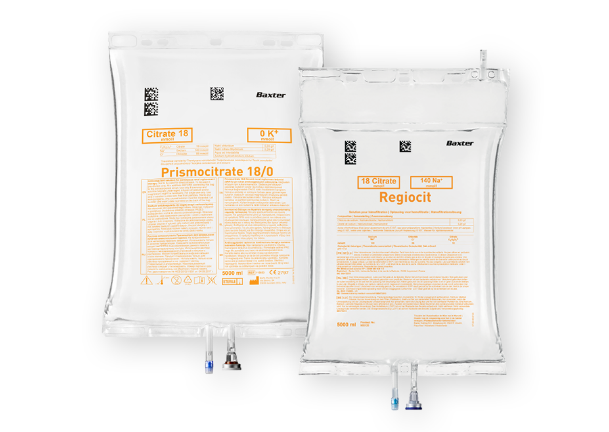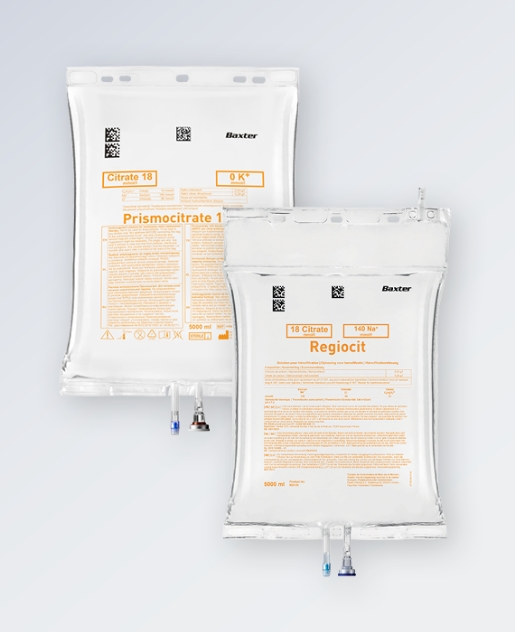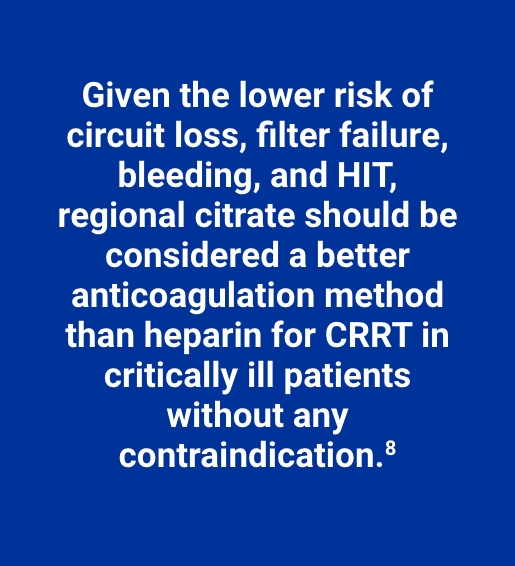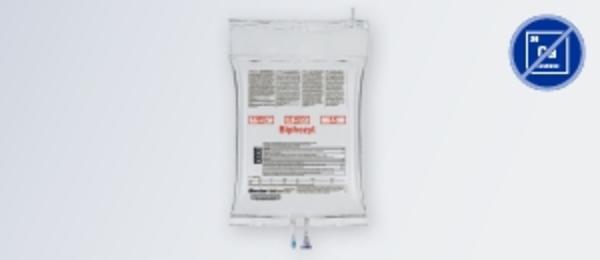Solutions for Regional Citrate Anticoagulation (RCA)
Simplify therapy delivery and help enhance patient safety with our solutions purposefully designed for RCA during CRRT

As a pioneer within the field of solutions for RCA, we developed the first ever drug-registered citrate solution indicated as replacement fluid for CRRT using RCA. Committed to innovation and patient safety, our low-concentration citrate-buffered solution for RCA is purposefully designed for CRRT.1
How can our solutions for RCA help you optimize CRRT delivery?
Simplified Protocols
Our solutions for RCA, alongside the Prismaflex/PrisMax system and its integrated citrate/calcium management software, offer a choice of simplified protocols in both diffusive and convective therapies.2,3
Enhanced safety
Compared to hypertonic citrate solutions, our low-concentration citrate formulation developed for CRRT helps enhance patient safety and improve metabolic control.1,4-6
Improved efficiency
Compared to heparin, citrate-buffered formulation may help improve therapy delivery efficiencies by increasing filter life and helping minimize treatment downtime.5,7
"Given the lower risk of circuit loss, filter failure, bleeding, and HIT, regional
citrate should be considered a better anticoagulation method than heparin
for CRRT in critically ill patients without any contraindication."8M. Bai, M. Zhou, L. He, and F. Ma

Innovative citrate formulation designed for CRRT
Deliver CRRT optimally with our innovative low concentration citrate formulation developed specifically for CRRT in collaboration with HCPs.1,9 Compatible with a wide range of blood flow rates and weight-based protocols, this low-concentration citrate solution contributes to buffer generation and helps minimize the risk of citrate-related metabolic complications, even at high infusion rates.10,11 Due to its physiologic sodium concentration, this formulation also reduces the risk of hypernatremia in patients.5,12
Available commercially for use in CRRT with RCA, our citrate formulation helps maximize efficiencies in workflows for both pharmacy and nursing.13,16

Improved therapy delivery and enhanced efficiency with RCA protocols
Using citrate-based solutions for RCA deliver treatment with reduced risk of bleeding and thrombocytopenia when compared to heparin anticoagulation. With citrate, the risk of circuit loss and incidence of filter failure are also reduced – helping minimize therapy downtime and increase operational efficiency.8

Calcium-free bicarbonate-buffered solutions for RCA
Achieve treatment flexibility with our selection of calcium-free, bicarbonate-buffered solutions designed for RCA, both with and without phosphate.14,15 Calcium-free dialysis and replacement solutions are used during citrate anticoagulation to avoid antagonism of the anticoagulation effect. With our range of bicarbonate-based formulations, you can choose simplified protocols for both diffusive and convective therapies.2,3

Prismocitrate 18/0
Solution for regional citrate anticoagulation in CRRT.

Regiocit
Haemofiltration solution for regional citrate anticoagulation in CRRT.

Prism0cal range
Bicarbonate-buffered dialysis solutions for CRRT.

Biphozyl
Bicarbonate-buffered solutions for hemodialysis and hemofiltration.
For safe and proper use of the products mentioned herein, please refer to the Instructions for Use.
IMPORTANT SAFETY INFORMATION
This abbreviated summary of product characteristics (SPC) is intended for international use. Please note that it may differ from the licensed SPC in the country where you are practicing. Therefore, please always consult your country-specific SPC or package leaflet.
NAME OF THE MEDICINAL PRODUCT
Regiocit solution for haemofiltration
QUALITATIVE AND QUANTITATIVE COMPOSITION
|
Sodium chloride |
|
5.03 g/l |
|
Sodium citrate |
|
5.29 g/l |
|
|
|
mmol/l |
|
Sodium |
Na+ |
140 |
|
Chloride |
Cl- |
86 |
|
Citrate |
C6H5O73- |
18 |
|
Theoretical Osmolarity: 244 m0sm/l pH ≈ 7.4 |
CLINICAL PARTICULARS - THERAPEUTIC INDICATIONS
Regiocit is indicated as replacement fluid for continuous renal replacement therapy (CRRT) using regional citrate anticoagulation. Citrate is particularly relevant when systemic anticoagulation with heparin is contraindicated, for example, in patients with increased bleeding risks. In paediatric patients, Regiocit is indicated in all age groups provided that the equipment used is adapted to the weight of the child.
CONTRAINDICATIONS
Hypersensitivity to the active substance(s) or to any of the excipients listed in section 6.1 of the full SPC.
Severely impaired liver function.
Shock with muscle hypoperfusion.
SPECIAL WARNINGS AND PRECAUTIONS FOR USE
Regiocit is not for direct intravenous infusion. It should be used in predilution only, with appropriate extracorporeal renal replacement equipment intended for CRRT. The dialysis machine must be suitable for citrate anticoagulation.
Regiocit may be warmed to 37ºC to enhance patient comfort. Warming of the solution prior to use should be done with dry heat only. Solutions should not be heated in water or in a microwave oven due to the potential for patient injury or discomfort.
Regiocit should be inspected visually for particulate matter and discoloration prior to administration, whenever solution and container permit. Do not administer unless the solution is clear and the seal is intact. Use only if the overwrap and solution bag are undamaged. Use of a contaminated solution may cause sepsis and shock. Considering the composition of Regiocit, other solutions used in the treatment must have appropriate hydrogen carbonate concentration.
Regiocit contains citrate, which can influence the patient’s electrolyte and acid-base balance. The patient’s haemodynamic status, fluid balance, glucose level, electrolyte and acid/base balance should be closely monitored before and during treatment. Closely monitor sodium, magnesium, potassium, phosphate, and calcium. Blood concentration and patients’ needs should be assessed several times daily including assessment of infusate inputs and all outputs. Infusion of electrolytes may be needed to supplement any loss (see sections 4.8 and 4.9 of the full SPC).
Regiocit contains no calcium, and may lead to systemic ionized hypocalcaemia due to loss of calcium bound to citrate in the effluent and/or in the case of systemic citrate accumulation.
Regiocit contains no magnesium. Use of Regiocit may result in hypomagnesaemia due to CRRT effluent losses. Patient should be monitored as infusion of magnesium may be necessary.
Regiocit contains no glucose. Administration of Regiocit may lead to hypoglycaemia. Blood glucose levels should be monitored regularly.
Regiocit contains no potassium. The serum potassium concentration must be monitored before and during CRRT.
Accumulation of citrate due to metabolic failure:
Special attention is required in patients with liver failure (including e.g. liver cirrhosis or acute liver failure) or shock (see section 4.2 and 4.3 of the full SPC), metabolism of citrate may be markedly reduced and patients exposed to accumulation of citrate. If haemofiltration with citrate is applied in these patients, more frequent monitoring of citrate accumulation is advised. If the liver and skeletal muscles fail to metabolise citrate, hydrogen carbonate is not produced and citrate can accumulate. Metabolic acidosis and ionized hypocalcaemia ensue. Accumulation of citrate can be detected by monitoring ionized calcium, total calcium and hydrogen carbonate concentration in the blood. If citrate accumulates, the ratio of total to ionized calcium in the blood rises. If the total/ionized calcium ratio rises above 2.3, the citrate buffer should be reduced or stopped. To correct for metabolic acidosis, hydrogen carbonate has to be replaced. CRRT can be continued without anticoagulation or other means of anticoagulation have to be considered.
Accumulation of citrate due to inappropriate infusion:
Inappropriate infusion of too large amounts of citrate (see also section 4.9 of the full SPC) causes acute hypocalcaemia and metabolic alkalosis and may expose patient to neurologic and cardiac complications. Treatment consists of discontinuation of the citrate infusion and the infusion of calcium.
Systemic hypocalcaemia (low ionized calcium) may be the result of two different mechanisms:
- Insufficient compensation of calcium loss with citrate through the filter (low ionized calcium and low total calcium) which requires adjusting the flow rate of calcium solution for supplementation;
- Accumulation of citrate as a result of poor metabolism in the liver and muscles (high total calcium/ionized calcium ratio) which requires partial or complete switch from Regiocit to a replacement solution without citrate (continuous venovenous haemofiltration) or combined reduction or stopping of Regiocit flow rate and increase of the dialysate flow rate to increase the removal of citrate (continuous venovenous haemodiafiltration).
Systemic hypercalcaemia:
High total calcium with high ionized calcium may happen due to excessive perfusion of the calcium replacement solution. It requires reduction in the calcium solution flow rate.
High total calcium with high total calcium to ionized calcium ratio may be the result of calcium citrate accumulation in relation to excessive flow rate of citrate or inability to metabolize a sufficient amount of citrate. It should lead to reduction or discontinuation of citrate infusion.
Metabolic acidosis:
Citrate may accumulate if the liver and skeletal muscles fail to provide adequate metabolism of citric acid which can occur in liver cirrhosis or acute liver failure. In these cases, citric acid accumulates and metabolic acidosis results. In these patients, the classical anion gap rises as well, reflecting the increase in ionized citrate. In most circumstances, lactate also accumulates.
Metabolic acidosis as a result of a failure to metabolize citric acid can be diagnosed early by routine metabolic monitoring.
If citrate accumulation develops and/or metabolic acidosis develops or worsens during therapy with Regiocit, the infusion rate may need to be decreased or its administration stopped.
Metabolic alkalosis:
Some patients require and tolerate high citrate infusion rates to maintain ionized calcium levels in the extracorporeal circuit within the desired range. Regiocit contains citrate, which contributes to the overall buffer load. Additional sodium hydrogen carbonate (or buffer source) contained in the CRRT fluids or in other fluids administered during therapy may increase the risk of metabolic alkalosis. Metabolic alkalosis may occur if the net citrate administration rate exceeds that which is necessary to maintain acid–base balance (see section 4.2 of the full SPC).
This can be managed by reducing blood flow rate, thus allowing for a decrease in the citrate infusion rate into the patient. Metabolic alkalosis may also be managed by increasing dialysate flow rate which also maintains CRRT dose and by infusing 0.9% sodium chloride post-filter, or change the composition of the CRRT solution. Accumulation of citrate with metabolic alkalosis and hypocalcaemia may also occur if the patient has received a large volume of citrate containing blood products and CRRT dose is too low. Blood calcium levels should be monitored regularly in patients with metabolic alkalosis since this condition may potentiate hypocalcaemia.
Use in Patients with Hepatic Impairment
Metabolism of citrate (to bicarbonate) may be impaired in patients with hepatic impairment, resulting in accumulation of citrate. If Regiocit is administered to patients with mild to moderate hepatic impairment (e.g., Child-Pugh ≤12), frequent monitoring of pH, electrolytes, total-to-ionized calcium ratio, and systemic ionized calcium is important to avoid electrolyte and/or acid-base imbalance (see Section 4.2). Regiocit should not be used in patients with severe hepatic impairment (see Section 4.3 of the full SPC).
Hemodynamic Status and Fluid Balance
The patient’s hemodynamic status and fluid balance should be monitored throughout the procedure.
- In case of hypervolaemia, the net ultrafiltration rate prescribed for the CRRT device can be increased, and/or the rate of administration of solutions other than replacement fluid and/or dialysate can be reduced.
- In case of hypovolaemia, the net ultrafiltration rate prescribed for the CRRT device can be reduced, and/or the rate of administration of solutions other than replacement fluid and/or dialysate can be increased.
Hypoosmolarity/Hypotonicity
Regiocit is hypoosmolar/hypotonic relative to standard CRRT replacement fluids and should be used with caution in patients with traumatic brain injury, cerebral oedema, or increased intracranial pressure. The instructions for use must be strictly followed. Incorrect use of the access ports or other restrictions to fluid flow might lead to incorrect patient weight loss and may result in machine alarms. Continuing treatment without resolving the originating cause may result in patient injury or death. Use only if the solution is clear and free from visible particles.
CRRT results in sodium removal proportional to plasma water sodium content. To avoid a drop in the blood sodium level in the patient (hyponatraemia) sodium losses must be balanced as part of overall fluid and electrolyte management (see section 4.8 of the full SPC). Administration of both CRRT related dialysis fluids and those outside of the CRRT prescription require careful assessment.
FERTILITY, PREGNANCY AND LACTATION
Fertility: no effects on fertility are anticipated, since sodium, chloride and citrate are normal constituents of the body.
Pregnancy and lactation: there are no documented clinical data on the use of Regiocit during pregnancy and lactation. Regiocit should only be administered to pregnant and lactating women if clearly needed.
UNDESIRABLE EFFECTS
Undesirable effects can result from the Regiocit solution or the dialysis treatment.
The following undesirable effects have been described in published literature (very common (≥1/10); common (≥1/100 to <1/10); uncommon (≥1/1,000 to <1/100); rare (≥1/10,000 to <1/1,000); very rare (<1/10,000); not known (cannot be estimated from the available data):
Undesirable effects related to the solution:
• Common undesirable effects are: electrolyte imbalances (e.g. hypomagnesaemia, hypocalcaemia, hypercalcaemia, hyponatraemia, hypokalaemia, hypophosphataemia); disturbances in acid-base balance including metabolic acidosis and metabolic alkalosis;
• Not known undesirable effects are: fluid retention, fluid imbalance (e.g. dehydration)
Undesirable effects related to the dialysis treatment:
• Not known undesirable effects are: hypotension, nausea, vomiting, muscle spasms
Reporting suspected adverse reactions after authorisation of the medicinal product is important. It allows continued monitoring of the benefit/risk balance of the medicinal product. Healthcare professionals are asked to report any suspected adverse reactions via their national reporting system.
For posology, incompatibilities, interactions, overdose, pharmacological properties and pharmaceutical particulars, please refer to the full SPC.
Medicinal product subject to medical prescription.
March 2019
NAME OF THE MEDICINAL PRODUCT
Biphozyl solution for haemodialysis/haemofiltration
QUALITATIVE AND QUANTITATIVE COMPOSITION
Biphozyl is presented in a two-compartment bag. The final reconstituted solution is obtained after opening the peel seal and mixing the contents of the two compartments.
|
BEFORE RECONSTITUTION |
|
|
|
Composition in the small compartment: |
|
|
|
Magnesium chloride hexahydrate |
3.05 g/l |
|
|
Composition in the large compartment: |
|
|
|
Sodium chloride |
7.01 g/l |
|
|
Sodium hydrogen carbonate |
2.12 g/l |
|
|
Potassium chloride |
0.314 g/l |
|
|
Disodium phosphate dihydrate |
0.187 g/l |
|
AFTER RECONSTITUTION |
|
|
|
|
Composition of the reconstituted solution: |
|
|
|
|
|
|
mmol/l |
mEq/l |
|
Sodium |
Na+ |
140 |
140 |
|
Potassium |
K+ |
4 |
4 |
|
Magnesium |
Mg2+ |
0.75 |
1.5 |
|
Chloride |
Cl- |
122 |
122 |
|
Hydrogen phosphate |
HPO42- |
1 |
2 |
|
Hydrogen carbonate |
HCO3- |
22 |
22 |
|
Theoretical osmolarity: 290 mOsm/l pH ≈ 7.0-8.0 For the full list of excipients, see the full SPC. |
|
|
|
CLINICAL PARTICULARS
THERAPEUTIC INDICATIONS
Biphozyl is used as replacement solution and as dialysate for treatment of acute kidney injury during continuous renal replacement therapy (CRRT). Biphozyl is used in a post-acute phase after initiation of renal replacement therapy when pH, potassium and phosphate concentration have returned to normal. Biphozyl is also used when other buffer sources are available as well as during regional citrate anticoagulation. Moreover, Biphozyl is used in patients with hypercalcaemia. Biphozyl may also be used in cases of drug poisoning or intoxications when the substances are dialysable or filterable.
CONTRAINDICATIONS
Hypersensitivity to the active substance(s) or to any of the excipients listed in section 6.1 of the full SPC.
Hypocalcaemia unless calcium is provided to the patient by other sources. Hyperkalaemia.
Hyperphosphataemia.
SPECIAL WARNINGS AND PRECAUTIONS FOR USE
The solution should be used only by, or under the direction of a physician competent in CRRT treatments using haemofiltration, haemodiafiltration and haemodialysis.
Warnings:
Biphozyl should not be used in patients with hyperkalaemia (see section 4.3 of the full SPC). The serum potassium concentration must be monitored before and during haemofiltration and/or haemodialysis.
Because Biphozyl is a potassium-containing solution, hyperkalaemia may occur transiently after treatment is initiated. Decrease the infusion rate and confirm that the desired potassium concentration is achieved. If hyperkalaemia does not resolve, stop administration promptly.
If hyperkalaemia develops when Biphozyl is used as dialysate, administration of a potassium-free dialysate may be necessary to increase the rate of potassium removal.
Because Biphozyl is a phosphate-containing solution, hyperphosphataemia may occur transiently after treatment is initiated. Decrease the infusion rate and confirm that the desired phosphate concentration is achieved. If hyperphosphataemia does not resolve, stop administration promptly (see section 4.3 of the full SPC).
Electrolyte and blood acid-base parameters should be monitored regularly in patients treated with Biphozyl. Biphozyl contains hydrogen phosphate, a weak acid that can influence the patient’s acid-base balance. If metabolic acidosis develops or worsens during therapy with Biphozyl, the infusion rate may need to be decreased or its administration stopped.
Because Biphozyl contains no glucose, administration may lead to hypoglycaemia. Blood glucose levels should be monitored regularly in diabetic patients (including careful consideration of patients receiving insulin or other glucose lowering medications), but also considered in non-diabetic patients, e.g. risk for silent hypoglycemia during the procedure. If hypoglycaemia develops, use of a glucose-containing solution should be considered. Other corrective measures may be necessary to maintain desired glycaemic control.
The Instructions for Use (see section 6.6 of the full SPC) must be strictly followed. The solutions in the two compartments must be mixed before use. Use of a contaminated solution may cause sepsis and shock. Use only with an appropriate extracorporal renal replacement equipment.
Special precautions for use:
Biphozyl is calcium free and could cause hypocalcaemia (see section 4.8 of the full SPC). Infusion of calcium might be necessary.
Biphozyl may be warmed to 37°C to enhance patient comfort. Warming of the solution prior to use should be done before reconstitution with dry heat only. Solutions should not be heated in water or in a microwave oven. Biphozyl should be inspected visually for particulate matter and discoloration prior to administration, whenever solution and container permit. Do not administer unless the solution is clear and the seal is intact.
Haemodynamic status, fluid balance, electrolyte and acid-base balance should be closely monitored throughout the procedure including all fluid inputs and outputs, even those not directly related to CRRT.
The content of hydrogen carbonate in Biphozyl is at the lower end of the normal range for blood concentration. Biphozyl is appropriate when using citrate anticoagulation, as citrate is metabolised to hydrogen carbonate, or when CRRT has been able to restore normal pH values. Assessment of buffer needs through measurement of repeated blood acid/base parameters and review of the overall therapy is mandatory. A solution with higher hydrogen carbonate content may be required.
In case of hypervolaemia, the net ultrafiltration rate prescribed for the CRRT device can be increased and/or the rate of administration of solutions other than replacement fluid and/or dialysate can be reduced.
In case of hypovolaemia, the net ultrafiltration rate prescribed for the CRRT device can be reduced and/or the rate of administration of solutions other than replacement fluid and/or dialysate can be increased. (see section 4.9 of the full SPC).
For general therapy related precautions/contraindications see section 4.3 of the full SPC.
FERTILITY, PREGNANCY AND LACTATION
Fertility: no effects on fertility are anticipated, since sodium, potassium, magnesium, chloride, hydrogen phosphate and hydrogen carbonate are normal constituents of the body.
Pregnancy and lactation: there are no documented clinical data on the use of Biphozyl during pregnancy and lactation. Biphozyl should only be administered to pregnant and lactating women if clearly needed.
UNDESIRABLE EFFECTS
Undesirable effects can result from the Biphozyl solution used or the dialysis treatment.
The following undesirable effects are reported from post-marketing experience. Hydrogen carbonate-buffered haemofiltration and haemodialysis solutions are generally well tolerated.
Undesirable effects related to the solution:
• Undesirable effects are (frequency not known): electrolyte imbalances (e.g., hypocalcaemia, hyperkalaemia, hyperphosphataemia), acid-base balance disorders (e.g., metabolic acidosis).
Undesirable effects related generally to the dialysis treatment:
• Undesirable effects are (frequency not known): fluid imbalance (e.g., hypervolaemia, hypovolaemia), hypotension, nausea, vomiting, muscle cramps.
Reporting suspected adverse reactions after authorisation of the medicinal product is important. It allows continued monitoring of the benefit/risk balance of the medicinal product. Healthcare professionals are asked to report any suspected adverse reactions via their national reporting system.
For posology, incompatibilities, interactions, overdose, pharmacological properties and pharmaceutical particulars, please refer to the full SPC.
Medicinal product subject to medical prescription.
June 2018